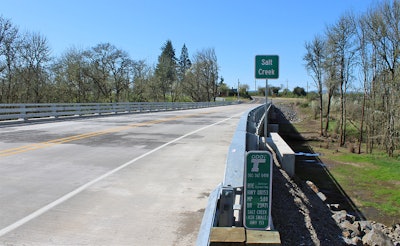
Internal-curing concrete offers a series of benefits for bridge deck construction, the main one being resisting shrinkage cracking. But it takes some effort in persuading contractors of the benefits, as the Oregon Department of Transportation learned.
So the Oregon DOT took steps to make the concept easier to understand and more accessible to implement, according to a recent report from the Federal Highway Administration’s magazine Innovator.
ODOT began piloting internal curing – placing moisture within concrete to fight premature shrinkage cracking – in 2017 and had completed 15 projects using it by 2023. However, the department found contractors were not embracing the new process, due to a perceived risk in using a new material.
How Internal Curing Works
Implementing internal curing offers an improved alternative to conventional curing, where water is applied only to the concrete’s surface.
The main goal is to extend the life of bridge decks – by 25-50 years – by making them less susceptible to the long-standing issue of shrinkage cracks. This process occurs when concrete loses its moisture during the day and cracks form, giving water and other materials a pathway inside the structure and leading to unplanned maintenance down the line to address the bridge’s structural integrity.
According to the Federal Highway Administration, the most common form of internal curing involves replacing a portion of normal-weight fine aggregate with pre-wetted lightweight aggregates that have a high-absorption capacity. This distributes curing water throughout the concrete body and rehydrates it as the concrete naturally dries out due to continued hydration or environmental exposure.
The process is primarily used in concrete bridge decks where it can provide improved protection to the steel reinforcement when coupled with lower-permeability mixture designs. However, it has applications in paving and overlays and for patching and repair.
Current departments using internal curing on bridge decks include New York State, Indiana, Louisiana, North Carolina, Ohio and Utah DOTs.
Minimizing Risk, Showing Results
A turning point came in 2021, when ODOT’s Bear Creek Bridge project – which would use internal curing – received a bid four times higher than ODOT’s engineer’s estimate. Contractors found the concept risky and struggled to see the value. They also wanted a lifecycle cost-benefit analysis from ODOT.
The department paused its implementation of internal curing in 2021 to fine-tune the process and standards. Enticing contractors toward the new practice involved several changes to ODOT’s program, including simplifying specifications. The department began predetermining the amount of lightweight fine aggregate needed – around 350 pounds per cubic yard – instead of simply providing contractors with a formula. Contractors also got offered educational activities and a list of approved sources for qualified products to use during bid and mixture design development.
The department also modified their testing method for better aggregate conditioning and quality control during concrete production, in order to improve consistency and streamline processes for contractors.
ODOT also brought together some analysis and data for contractors. An ODOT survey of 11 internally cured bridge decks found the new process had produced a 70% reduction in crack density.
ODOT also performed a cost-benefit analysis and found, when accounting for service life and maintenance, internally cured bridge decks were cost comparable with traditional concrete even when paying three times the bid price on a normal deck mixture.
Current efforts to continue improving the use of internal curing for contractors include attempts to cut the wet-cure duration for internally cured bridges from seven to 14 days. Internal curing is now ODOT’s default standard concrete for bridge decks, and the department is investigating its future use in paving and overlays.












